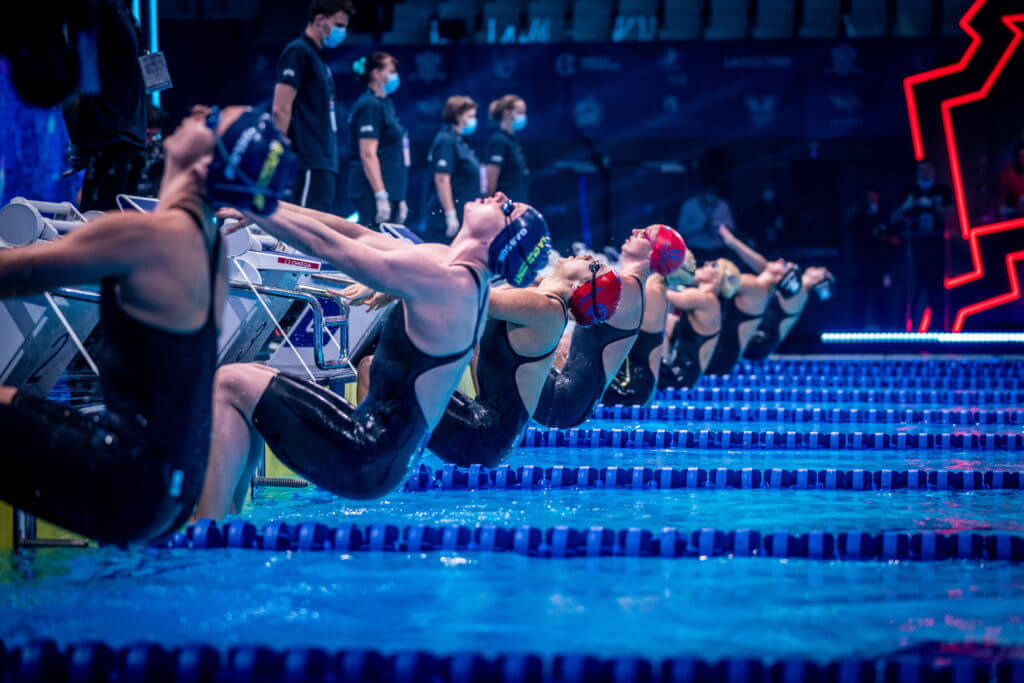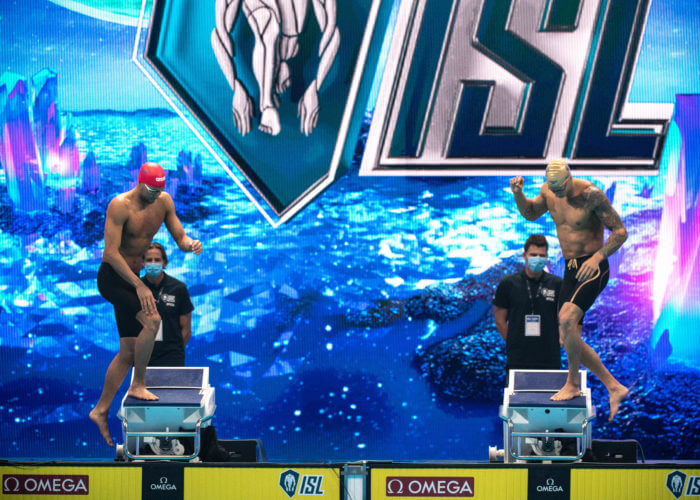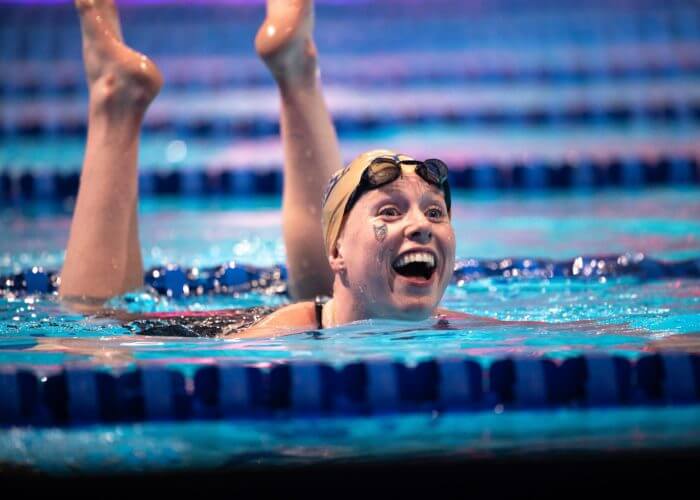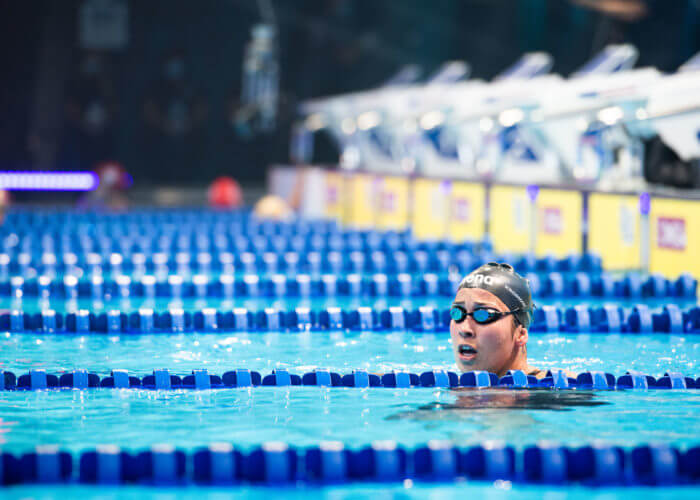Analyzing the International Swimming League’s Improvements From 2019 to 2020

Analyzing the improvements in the International Swimming League’s second season.
Live swimming is finally back! In a year that was supposed to see the thrill of the Olympic Games where swimming would dominate the international sporting headlines for eight days, the coronavirus pandemic had other ideas – pushing the Games back a full year in order to still hold a quadrennial event safely. Since mid-March, swimming fans have been starved of real competition, with only little teasers of intrasquad meets or small timed final events around the world.
This weekend’s ISL action in Budapest filled the void of no swim meets this year, and gave swimming fans a chance to feel normal again in a year that has been anything but. Masks were still worn in the team boxes, and no more than two swimmers were allowed in he warm-up pool at a time to adhere to social distancing because of the ongoing COVID-19 pandemic. But the racing itself felt just like a normal swim meet.
The ISL swimmers are all staying on Margaret Island in Hungary as all racing is being conducted in the Duna Arena in Budapest, home of the 2017 Worlds, which has quickly become one of the top swimming venues in the world.
As a swimming fan, it felt good to return to following live swim meets, with unpredictable outcomes and great race strategies at play.
The International Swimming League is in its second year as a professional sporting league, and it has been a long time coming for hardcore fans of the sport that wanted a chance to follow swimming outside of the normal summer months. Last season, the ISL was a welcomed addition to the swimming calendar, as there were plenty of upsides to the brand new, never-before-seen format of swimming.
Last season at the conclusion of the League’s debut, Swimming World’s staff laid out some changes they would like to see in the League moving forward. We don’t know if the League organizers listened to us, but there were some noticeable changes in the first four days in Budapest that were laid out at the end of last season.

Chad Le Clos & Caeleb Dressel take their blocks. Last season, Energy and the Condors wore blue caps, but this season wore distinctively different caps. Photo Courtesy: Mike Lewis / International Swimming League
- Problem: Team colors – there were just eight teams: Energy Standard, Cali Condors & LA Current all chose navy blue, while Iron & Breakers chose black. More teams will be formed: color and branding and setting each apart could and should be sharper and more inventive.
- Solution: In each of the first two matches, the teams all had a specific color cap to wear – Energy wore red, Condors wore gold, Current wore purple, and the Breakers wore black, while in the second match, Roar wore gold, Trident wore red, Centurions wore white, and Iron wore black. This was much easier to follow with specific color schemes.
- Problem: No readily accessible live timing – to have that for fans would not matter to the wider audience the emphasis on racing (not clock) is supposed to attract.
- Solution: It wasn’t perfect, but the ISL has done a better job of updating a media guide with live results: http://mediainfo.u.isl.global/2020/02_Match_2/
- Problem: By introducing freestyle spin bias, the League risks aliening fans who recognize that some outstanding swimmers, distance, strokes, are being deliberately disadvantaged. Sprint freestylers handed a gold ticket of huge advantage when it comes to MVP status and the rewards that might flow.
- Solution: The winning team of the medley relay gets to choose the stroke of the Skins event at the end of the meet. So far we have seen breaststroke and backstroke Skins, with Lilly King and Ranomi Kromowidjojo winning MVP status from the opening meet. As the season goes along, the other strokers on the teams will need to be ready to go when their name is called for the Skins as the medley relays have become that much more important since the meet could come down to the nitty gritty and the Skins could decide the final outcome.

Skins winner Lilly King. Photo Courtesy: Mike Lewis / International Swimming League
- Problem: A season that runs from September to April void of the clutter of the current requires a big cultural and organizational shift in the sport: trials season is often March-April-May for many countries, whose swimmers are unlikely to want to be at an ISL Final ion it costs them a place on their national team for Olympic Games, World Championships and events that matter yet.
- Solution: The COVID-19 pandemic has caused the ISL to organize this condensed schedule from mid-October to the end of November. It is roughly the same timeline that the League produced last season with the final being held just before Christmas. Avoiding ISL meets during Trials season in March, April, May, June will keep an organized calendar and allow athletes to have a large racing schedule in the fall, concluding with a rest in the spring, all in preparation for the big show at the end of the summer.
- Problem: TV production is weak. They try to get too fancy with camera angles. Keep it simple!
- Solution: Without the spider iso camera that would zoom in on the leader during the race, the wide camera angles that keep all eight swimmers in frame (or at least the swimmers in contention of the lead) make it easier to follow for fans at home who may have different rooting interests than the swimmer out in front. There weren’t any events where the race for second was lost because of the iso camera on the leader.

Match MVP Ranomi Kromowidjojo. Photo Courtesy: Mike Lewis / International Swimming League
- Problem: There was too much time between the meets, particularly between the Derbies and the championship meet. In the lull, too much time exists for the ISL to be forgotten and fall off the radar.
- Solution: The condensed bubble schedule has helped this. There are five days before match three where the Tokyo Frog Kings and Toronto Titans will make their debut, and after that there will be a maximum three days between matches. It may be exhausting for the swimmers, but swimming is approaching basketball levels of prominence – nearly every day will hold a swim meet.
- Allowing the entirety of the season to be held in the same pool allows for the other non-competing swimmers to watch their peers in the venue, giving themselves a chance to scout their opposition moving forward.
- Iron’s Katinka Hosszu:
- “We were out here watching (the first meet) live. We haven’t been in competition for so long, we were so excited to watch the guys race and see how the meet goes. Energy and Cali Condors are really strong teams so I think for Iron we are really taking it match by match. We had a couple guys out who are coming back and joining us so we are definitely excited for that. Hopefully we can get a couple swims that are stronger for Team Iron and getting more points. We are focusing on getting to the Semis – that is our number one goal and we are going from that. In this situation you never really know what is going to happen with the teams as we see the lineup is always changing and the team is mixing. So the focus for us now is getting in the semis.
- Problem: The bottom teams, particularly the N.Y. Breakers, were out of their league when it came to a competitive balance. Due to this imbalance, the intrigue in the team race was lessened. The Derbies felt too predictable for “elimination matches.”
- Solution: The Tokyo Frog Kings roster is stacked, and with the addition of the Toronto Titans, it looks like there are six or seven teams capable of advancing to the final with only four slots available. The work that the Cali Condors have done in the off-season as well as the London Roar’s additions of James Guy and Freya Anderson coming in this week make the team race up for grabs between those two teams plus the Frog Kings and Energy Standard.
- Problem: Seeding: random lane assignments can lead to difficulty in watching when two best swimmers are in lane 1 & 8.
- Solution: It appeared that the lane assignments were done based on team standings, putting the top two teams in lanes 3 – 6, making the races easier to view. You had the occasional outside smokes but it wasn’t a constant eye strain.
- Problem: Vegas on the cusp of Christmas: hellishly expensive for folk to get to, particularly at this time of year – and that thought includes mainstream media and budgets set over a year in advance, as mentioned elsewhere in these notes.
- Solution: The COVID pandemic solved this for the ISL, but keeping the bubble in a swimming-centric city like Budapest in one of the best facilities in the world – and not to mention in a centralized location for optimal viewing across the globe, was a fantastic idea. Last season, the final was in Vegas, but Vegas is not known as a swimming city, so the crowds were less than ideal and not full. Moving forward, Budapest, London, Rome, Indianapolis, and even Sydney are known as great swimming cities with fans that will show out.
The league is still not perfect, with some minor things swimming fans are so accustomed to seeing missing from the league.
With new rules added like the jackpot times, it has thrown some of those involved for a loop as they try to grasp how to adjust their line-ups without getting jack-potted. The jackpot is designed to reward winning swimmers for beating the opposition by a specific pre-determined margin, so if the other swimmers finish a certain distance behind, then they get their points taken away.
LA Current head coach David Marsh said to Eurosport at the end of day one, with a tone of bewilderment in his voice: “This jackpot is crazy – I mean what the heck?”
London Roar breaststroker Alia Atkinson shared her thoughts on the jack-pot at a virtual press conference Monday:
“It is something new for ISL. It’s something new for teams and swimmers. We’ll see where it goes from there. It’s really difficult as an athlete to give your best for the team and come in and all your points are stolen and you swam that race for no reason. But I’m sure there’s a reason. I’m sure it creates excitement and puts a fire in the other athletes to keep on going, so we’ll see how that plays out.”
The format of the International Swimming League is still something swimming fans are getting used to, but with such a long time away from racing, many are just happy to be back.
.jpg)
- ISL WEBSITE
- SEASON 2 SCHEDULE
- EUROPEAN ROSTERS
- AMERICAN ROSTERS
- TOKYO & TORONTO NEW ROSTERS
- CBS TV AGREEMENT
- MATCH ONE RESULTS (CONDORS, ENERGY, CURRENT, BREAKERS)
- MATCH TWO RESULTS (ROAR, IRON, TRIDENT, CENTURIONS)
- MATCH THREE RESULTS (CURRENT, FROG KINGS, TITANS, CENTURIONS)
- MATCH FOUR RESULTS (CONDORS, IRON, BREAKERS, TRIDENT)
- MATCH FIVE RESULTS (ROAR, CURRENT, FROG KINGS, TRIDENT)
- MATCH SIX RESULTS (ENERGY, TITANS, BREAKERS, CENTURIONS)
- MATCH SEVEN RESULTS (ENERGY, IRON, TITANS, TRIDENT)
- MATCH EIGHT RESULTS (CONDORS, ROAR, FROG KINGS, BREAKERS)
- MATCH NINE RESULTS (ENERGY, FROG KINGS, IRON, TITANS)
- MATCH TEN RESULTS (CONDORS, CURRENT, ROAR, CENTURIONS)
- SEMI ONE RESULTS
- SEMI TWO RESULTS
- GRAND FINAL RESULTS




Great photo!